Kellogg Community College in Battle Creek, Michigan, found itself in a bind: After a marked enrollment decline, the Higher Learning Commission required the college to submit a comprehensive enrollment management plan.
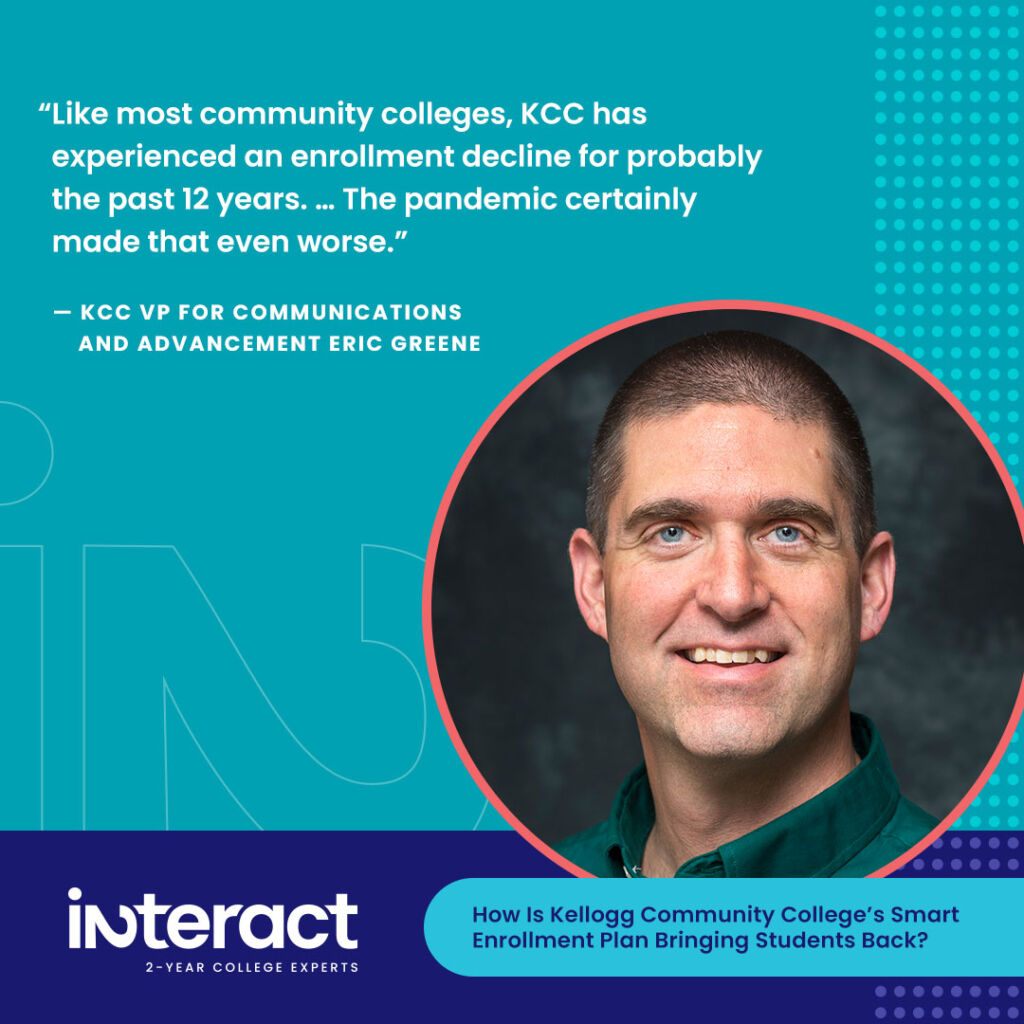
“Like most community colleges, KCC has experienced an enrollment decline for probably the past 12 years, to the tune of approximately 50% of our student population,” says Vice President for Communications and Advancement Eric Greene. “The pandemic certainly made that even worse.”
The college resolved to get back on track and teamed up with Interact Communications to get a bird’s-eye view of its enrollment pipeline. With proper perspective and a new plan in place, KCC realized gains right away in improved student experience, securing outstanding alignment and agreement between departments, and making data-driven decisions to focus efforts.
Now, student enrollment is increasing because the college is addressing its vulnerable student populations effectively, smoothing over onboarding hurdles, and improving its outreach messaging. While making a strategic enrollment management plan is lengthy, the team started making positive changes and seeing great ROI immediately.
“I don’t think there’s a way we could have done this without Interact,” says Jenni Kotowski, Director of Admissions. “It was having that third party come in and listening so that people felt heard that made a difference.”
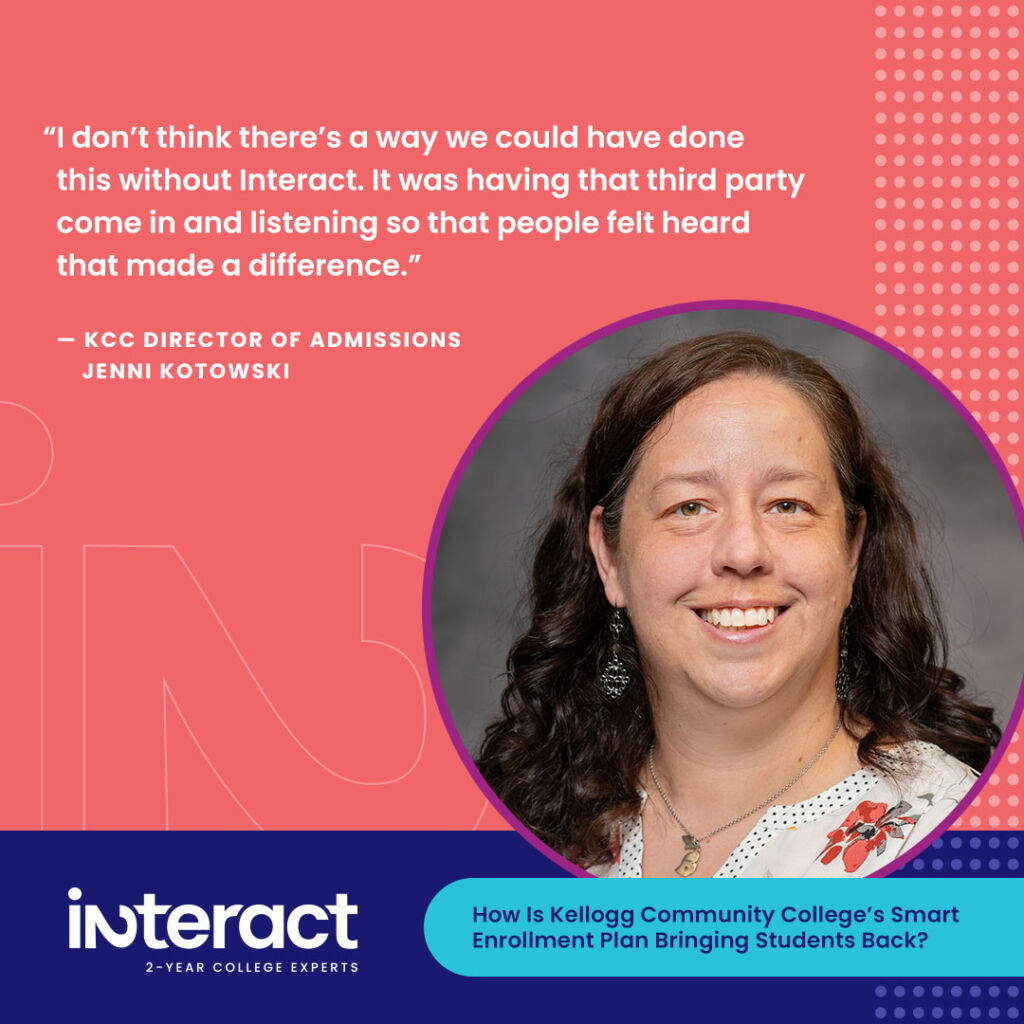
And this just in: KCC celebrated a +12% enrollment boost for Fall 2023!
Want to find out KCC’s secret to building a smart enrollment management plan? Keep reading to discover how they leveraged their research to better serve their students and bring them back to college!
Data-Driven Decisions Reshape Kellogg Community College’s Communications
Colleges can lose anywhere from 40% to 70% of their applicants during onboarding. Through diving deeply into failure-to-appear, failure-to-return, and student-onboarding research, KCC discovered that their communication and outreach needed strengthening to help students sign up and persist.
“So much of our loss in recruitment and getting people to actually sign up for classes occurs in the communications arena,” says Greene.
“A lot in our communication with students was too technical and jargon-y,” adds Kotowski. “Having Mary DeLuca and the team help us rewrite those to be more friendly and encouraging has been helpful.”
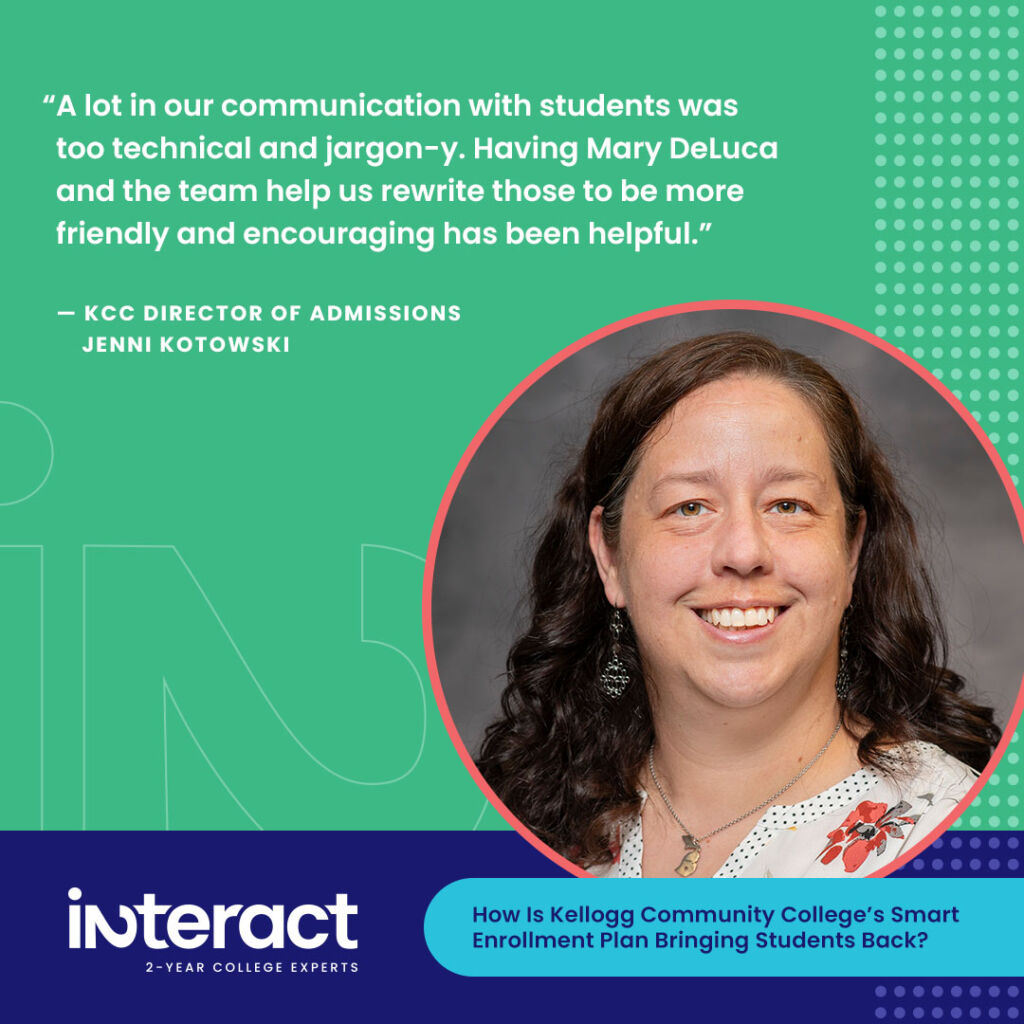
How did they fine-tune their communication and outreach? On top of robust, deep-funnel research, Interact’s Media Prefs survey helped KCC meet their students where they are.
The Inside Scoop on How KCC Targeted Student Audiences with Media Prefs
Kellogg Community College leveraged insights from the Media Prefs survey data to home in on students’ social media preferences. They discovered that while students do spend a lot of time on socials, they don’t want brands like their community college “invading their space.”
“While, of course, we’re still active on social media, we’re much more intentional, and we try not to oversaturate when it comes to posts and platforms we use,” says Greene.
Media Prefs data also revealed that students want more text messages, but only if they are targeted.
“I’m not doing a mass text with all the classes that are open, and half the classes the student has already taken or doesn’t need,” explains Kotowski, who says learners are responding positively to the new texting processes. “It’s very targeted toward that student and their needs.”
And while Kotowski says that the college marketing team intuited that better targeting texts would be the best practice, she says, “Having our Media Prefs data justified us needing to do a better job of it.”
Media Prefs Made a Difference
In fact, KCC was our all-star Media Prefs college during our last survey period because they had the most student participation!
“Media Prefs allowed us to have access to students who wouldn’t typically give us feedback … so that we had a holistic picture of what was needed,” says Kotowski.
“It allowed us a broad sample size to really be making decisions with all students in mind.”
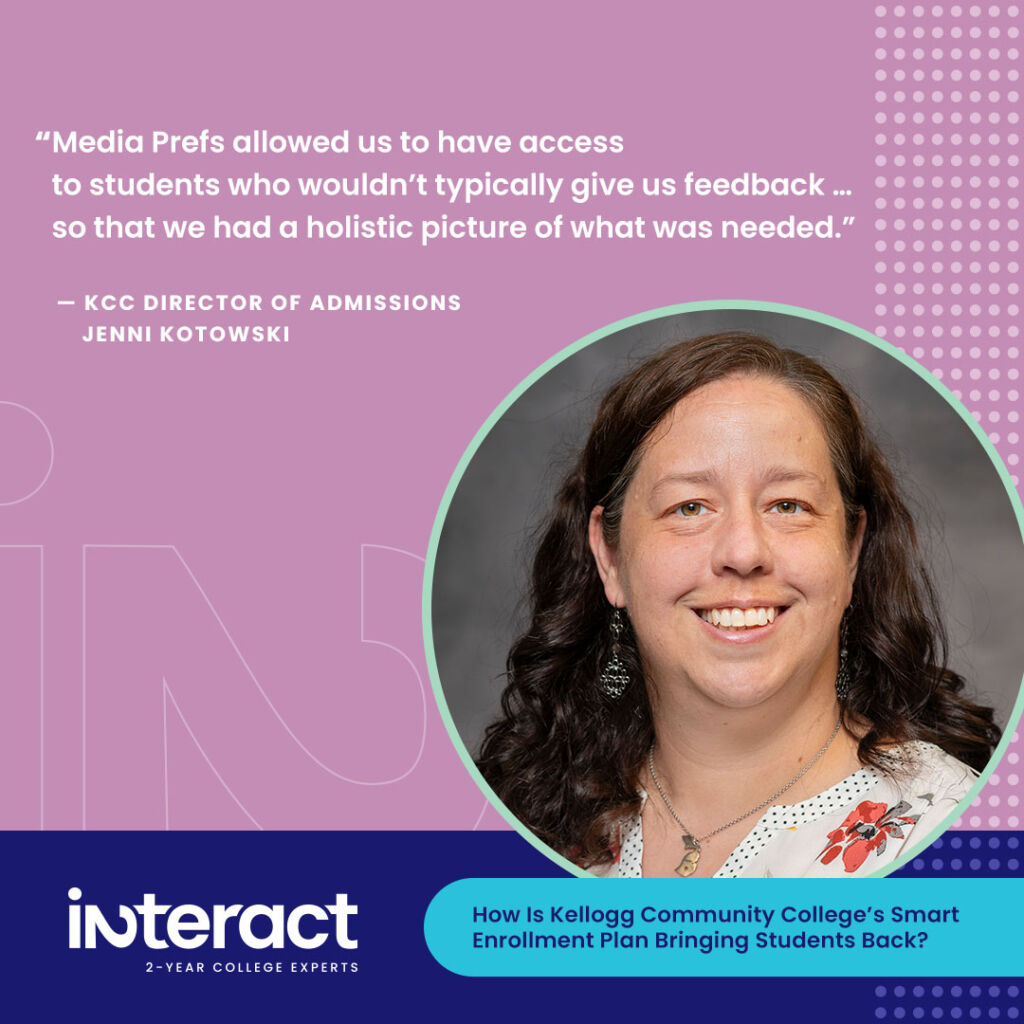
Greene adds, “Media Prefs is extremely helpful data that gave us a lot of competence in how we can segment and target different audiences.
“We’ll continue to do the Media Prefs survey and adapt as that data evolves.”
Interact is launching a new Media Prefs system that is more robust and easier to use than ever, giving colleges the crucial student insights they need for their marketing and enrollment efforts. Sign up for our newsletter and be the first to know when the new Media Prefs is here!
How Kellogg Community College Targeted Their Most Vulnerable Student Population and Boosted Enrollment!
Another insight from the team’s deep-funnel enrollment research and Media Prefs data was how to help their most vulnerable student population, which is adult learners. Previously, many assumed that only a lack of funds kept nontraditional students away. But through the data, the college discovered that adult learners really needed more flexibility and support in their studies.
“I think Media Prefs helped validate the things some of us were saying, that there’s something else stopping adult learners from either returning to college or starting their degree,” says Kotowski. “That was one of my big takeaways from Media Preferences.”
More than half of the college’s student population is over 24, with all the juggled responsibilities that come with being a returning student. Coming back to college could seem like a “daunting enterprise” without enough assistance. As Greene says, “They also need something that is going to fit with their very busy, committed lifestyle.”
Addressing Adult Students’ Unique Needs
That’s why KCC put adult students at the top of their enrollment plan and kick-started new part-time programs with flexible schedules on top of being cohort-based. The college knew from its deep-funnel research that adult students didn’t want to be outnumbered by younger students in classes. So, with a more supportive cohort structure in place and flexible scheduling, the new offerings already have had a powerful impact on enrollment.
In the new part-time nursing program alone, the college has received 55 applications for 24 seats, the first time the nursing program has had a waiting list instead of empty seats for some time. With the nursing program’s burgeoning popularity, leadership is now considering adding new sections.
“We are getting people as far away as Detroit, which is about two and a half hours away, who are applying for this program,” says Kotowski.
Greene adds, “Over the years, adult learners probably just determined that they couldn’t commit to the time that was required. Now that we have modified and customized something for that group, they are showing up.”
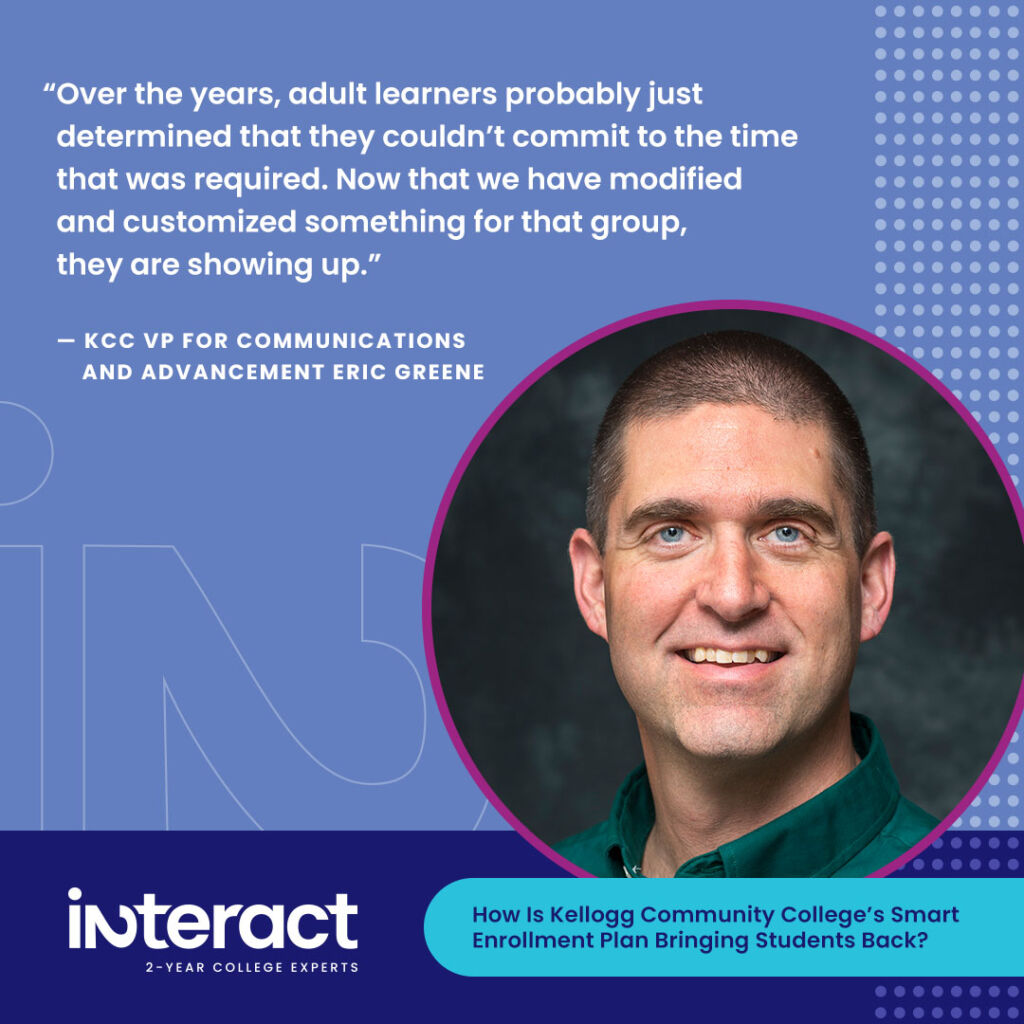
How Data Helped Fuel Fast Changes at Kellogg Community College
Often, when a college can step back and get the big picture of their institution with fresh data, it’s simple to spot and address easy fixes. For KCC, a quick fix that didn’t require any additional costs was clearing up confusing class registration jargon.
“When a class is reserved for certain students, it said ‘petitioned,’ and nobody knew what that meant,” says Kotowski, who previously had to field many confused student calls on the issue. As soon as the college changed that term to “restricted,” the phone lines got a lot quieter.
“We were able to have some quick wins right away, and that helped us to see momentum right from the beginning,” says Kotowski. “The research that Interact did for us allowed us to make informed decisions. Now, we have what students are legitimately saying and why we needed to make the changes.”
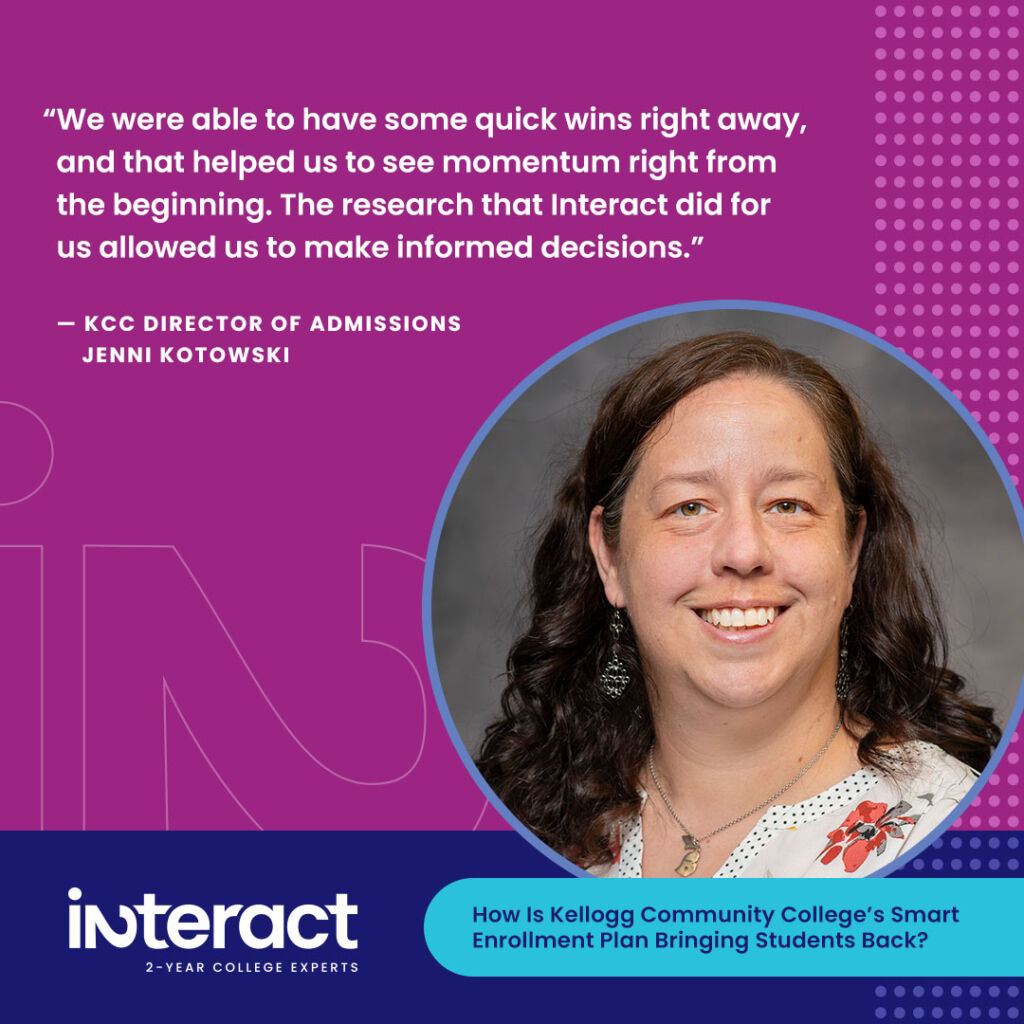
Enrollment Wins for Kellogg Community College
KCC has made some huge strides in its initiatives, and it’s already moving the needle on its enrollment. Here are just a few examples:
Removing Financial Aid Hurdles Encourages Enrollment
The popular Legacy Scholarship, managed by the Battle Creek Community Foundation, gives local high school students a boost and helps the college strengthen its enrollment pipeline. But obstacles were making students leave their financial aid money on the table and their college degrees behind.
KCC’s new data revealed that students had difficulty completing their FAFSA before getting their Legacy Scholarships. Meanwhile, the Battle Creek Community Foundation changed the requirements to be a first-dollar scholarship instead of last-dollar, helping overcome students’ FAFSA pain points, as shown in the research. Even better, now, students just have to apply for the Legacy Scholarship once instead of annually, and there are no longer any extra hurdles for taking summer classes. The result?
“We immediately saw an influx,” says Kotowski. Additionally, the college was able to secure grant money for a Legacy Scholarship success coach, who supports students from inquiry all the way through graduation. With the new policies in place, the college nearly tripled its number of Legacy Scholars.
And what about those graduating high school students who didn’t go to college during the pandemic?
Says Kotowski, “I’ve seen a lot of 2020 and 2019 grads starting to think about coming back to school and filling out Legacy applications.”
Removing Hurdles to Class Registration
Another initiative of the enrollment plan was to make the student indebtedness program permanent. Now, even if a student owes money to the college, they can still register for classes.
“Before the program, in many cases, they would never pay that debt, and we would never see the student again,” says Greene. “Now, we’re finding those students are registering for classes and paying their owed balances.”
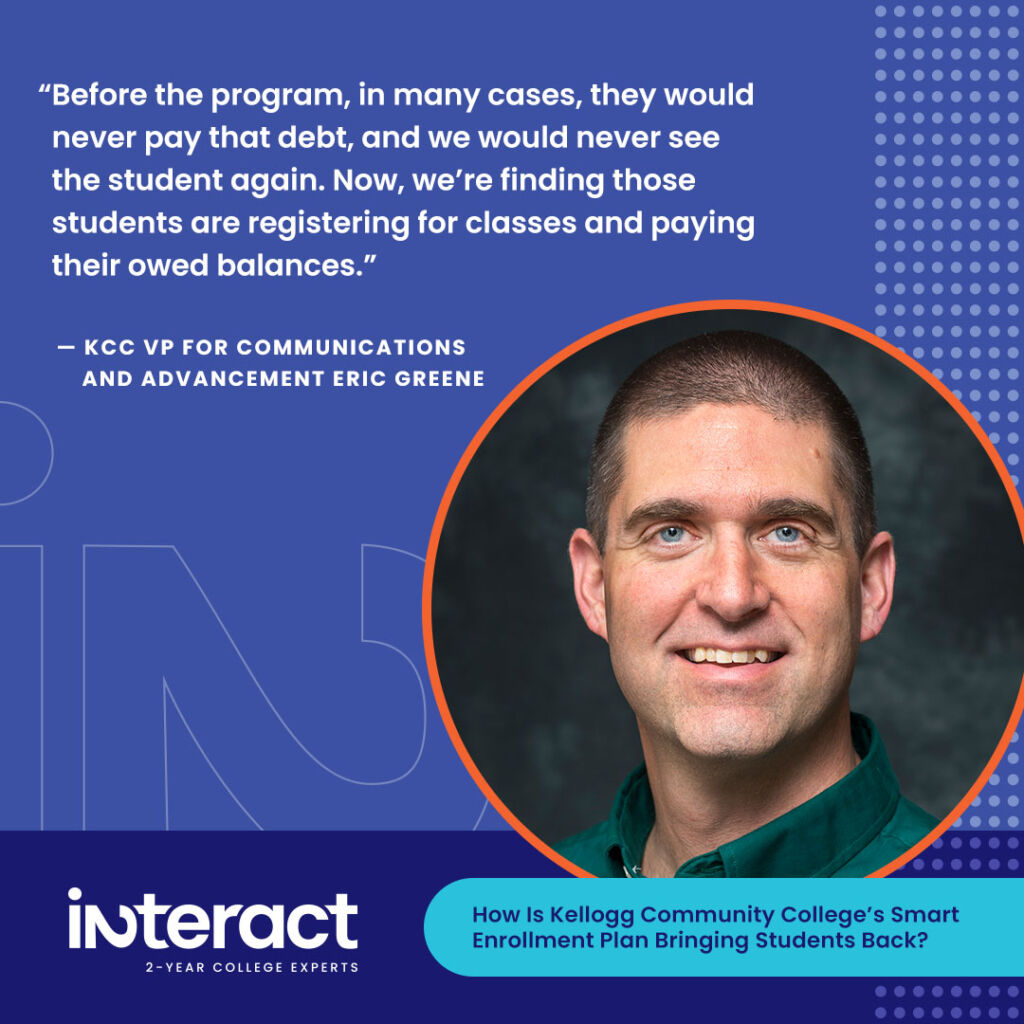
Overcoming the Community College Stigma with Stronger Transfer Agreements
Last but not least, the college renewed its articulation agreements with several local universities, which Greene says has paid dividends:
“The process allows us to make some noise about those agreements and let students know we’re paving a smooth pathway for them.”
Kotowski adds that the efforts are going a long way in combating the myth that community college credits don’t go anywhere. In fact, she recently spoke to a prospective student who was worried that none of his classes would transfer:
“Being able to show him that associate degrees will transfer right to the schools he’s interested in helped ease some of his concerns,” says the director of admissions. “He wants the small classroom experience but was really worried about wasting his time. Being able to show off our transfer agreements to students helps legitimize what we’re doing.”
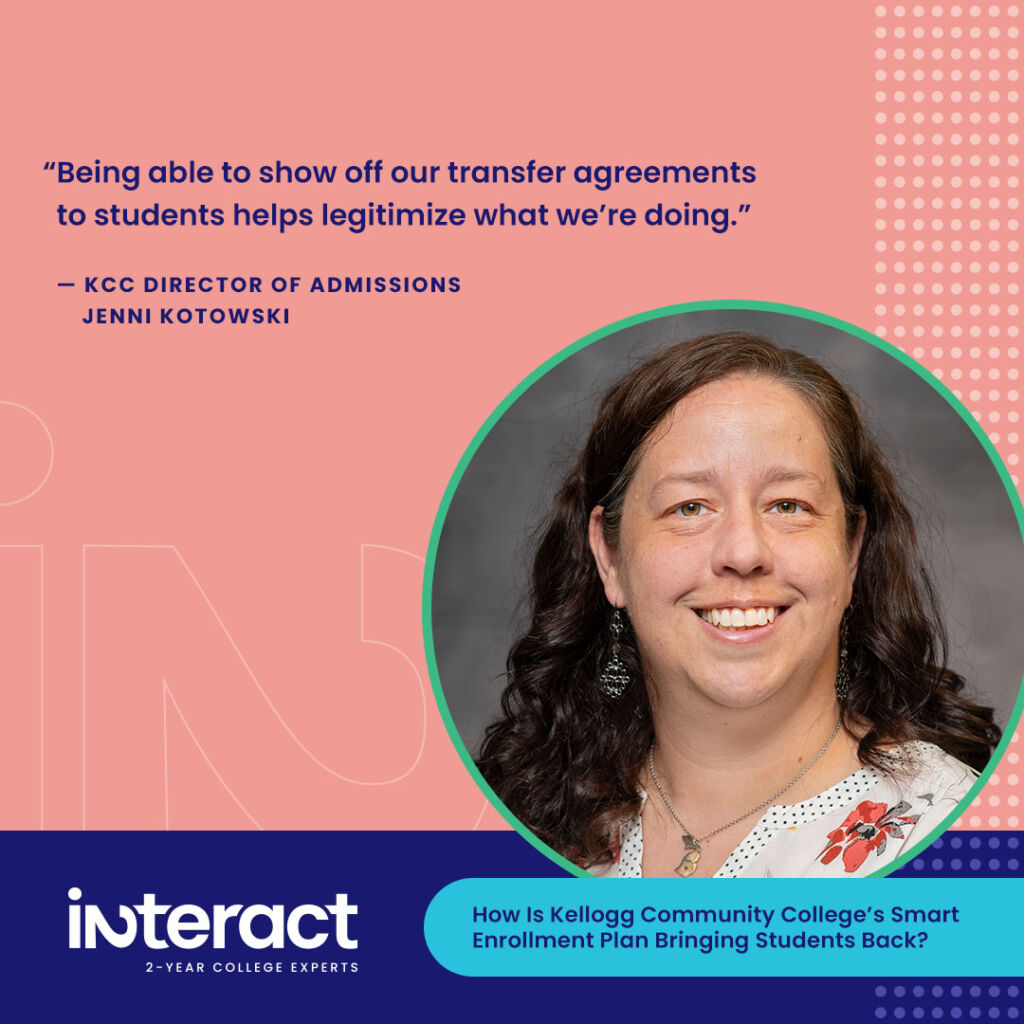
Kellogg Community College’s Advice for How to Do a Strategic Enrollment Management Plan
According to Kotowski, there are no quick fixes for strategic enrollment management plans. It will be a process, and you must have campuswide buy-in, especially from leadership.
Most of all, she says, “You have to love your students more than your processes! We need to let those processes go to ensure it’s in the best needs of the students.”

Greene adds that you don’t have to “eat the entire elephant” all at once when making a plan. What’s important is to get started moving in the right direction and stay committed to the process. He says, “Know that the product you are creating will be a living, breathing, evolving plan — it is not a one-and-done!”
Plus, Greene says that the secret to success was getting everyone on board at the college:
“We achieved a holistic approach by being very inclusive and comprehensive right from the beginning,” says the vice president. The process involved the entire enrollment management cabinet, breaking up silos and giving everyone ownership of the plan. Though juggling conflicting opinions wasn’t always easy, having an agency to facilitate alignment and agreement helped keep the teamwork strong. “Every version we made, we shared widely for edits, changes, and ideas. Interact worked with us to really fine-tune that.”
Having a Third-Party Perspective
KCC says that having a third-party perspective was key. Kotowski shares that if KCC would have had to do its plan on its own, “I think it would have been a lot of crying and a lot of fighting, and I’m not sure we would have had as good of a product.”
In particular, she says Interact offered the guidance and prompts the college didn’t even know it needed, which helped steer the team in the right direction.
“Interact has been a blessing to work with,” says Greene. “Mary and Diane have been great meeting facilitators and a godsend to work with.”
He says that when the KCC team became flummoxed over the next step they should take, “Mary and Diane were great about saying, ‘Well, this is how it typically goes at other colleges.’ … Every sort of challenge we were dealing with at KCC, they would assure us that they had seen this before and they had a variety of potential solutions for us to consider.
“This is an organization that knows community colleges inside out and backward!”

Could your college use some help with strategic enrollment management planning?
Join us for our upcoming webinar, where KCC and Interact will share strategic enrollment management secrets for success! Sign up for our upcoming event!



